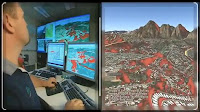
ESRI Education Manager, Joseph Kerski, wrote an article about the five skills or abilities needed for a successful career in the field of GIS. To-5 expertise or skill is 2 or 3 of them are also must-have skills [...]
Welcome to the Blog How to learn ArcGIS Most Complete
Home » Posts filed under Google and National Geospatial-Intelligence Agency
Diposting oleh Unknown

All Rights Reserved GIS MAPPING SYSTEM INFORMATION.
Distributed by Tutorial Blog